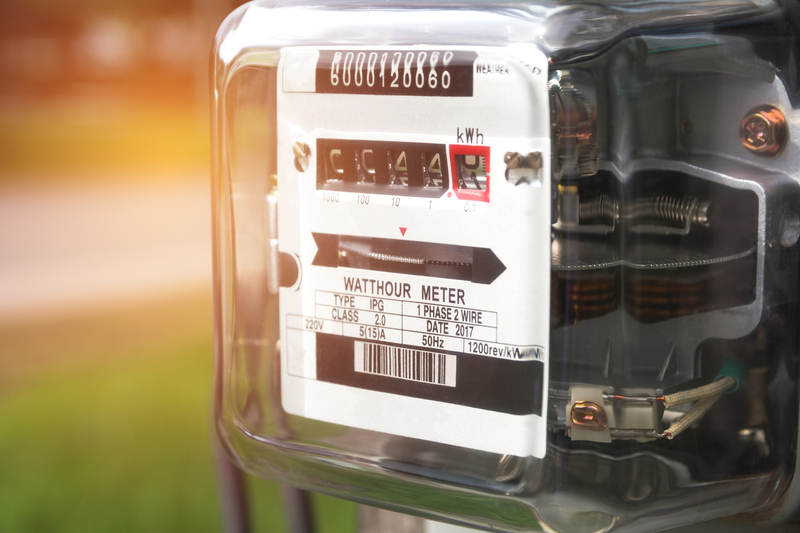How to Put Your Home on an Energy Diet Plan (20 Steps)

It’s hard to imagine life before electricity. Heck, it’s hard to imagine life before some of our most beloved electrical devices like smartphones, laptops, microwaves, TVs, etc. What about heating and cooling? With summer nearly here, air conditioners will be firing up all over the country (if they aren’t already). And when we spend more time at home, we can watch energy bills skyrocket, telling us just how much we depend on power sources like electricity, gas, and solar power. Fortunately, an energy diet plan can not only save you from soaring energy bills, it could make you more comfortable at the same time.
The first step is to assess your home’s “physical fitness.” While there are professionals who can perform an audit to let you know where your home may be leaking energy, you can find a lot of the issues just by walking through your home yourself.
If you live in an older home, you likely know of at least a few areas you need to address (for example, the winter draft that’s always blowing in thanks to the front window that needs repairs). Yet, even if your home was built fairly recently, you can likely find some opportunities to save energy. Keep in mind that technology is rapidly evolving in all areas, including energy saving, so keeping your home fit is an ongoing process.
Home Energy Assessment and Energy Diet Plan
□ Lighting Check
Lighting makes up about 5% to 10% of the total electric bill, so you’ll want to check to ensure you don’t have any of the older incandescent lights or energy-sucking, heat-producing halogen incandescent lights.
Energy Diet Plan: As your light bulbs burn out, take the opportunity to replace them with energy-saving light-emitting diodes (LEDs). Yes, they are more expensive upfront, but because they use so much less energy and last so much longer, they can actually save you hundreds of dollars. For comparison, LED bulbs produce 90 to 112 lumens (a measure of visible light) per watt, whereas compact fluorescent lights (CFLs) produce 40 to 70, and old-school incandescent bulbs produce just 10 to 17. It’s also worth noting that both CFLs and incandescent bulbs release 80 to 90% of their energy as heat. So not only is that money lost, if you’re trying to keep your home cool during the summer, that’s another great reason to switch to LEDs.
In addition, LED bulbs can last up to 50 years. Plus, they come in a wide variety of color spectrums to suit your needs. You can even find variations that provide a warm glow similar to familiar incandescent bulbs.
The cost for LEDs have dropped by up to 85% in recent years, and while the price range is quite vast, a good quality LED bulb averages around $5. That may seem high, but remember, they are up to 80% more efficient. When looking at the cost to operate, length of life, and cost of the bulb, one LED light can save well over $100 over a 10-year period.
To avoid significant upfront costs, you can simply replace your light bulbs as they go out with more efficient LEDs. Or better yet, replace the bulbs you use the most with the LEDs first. For example, even if your guest bedroom light (if you have one) were to go out first, you may instead choose to move the bulb(s) from your bedroom to the guestroom and put the more efficient LED light in the more frequently used room first.
By replacing just the five most frequently used lighting fixtures with LED bulbs, you can save up to $75 per year.
Another simple thing you can do to save energy: turn off unnecessary lights. Yep, just as your mom constantly reminded you, when you leave a room, flip the switch. And if you find you are constantly nudging others in the family to turn off lights and it’s not working as well as you’d hope (even if you’re the one forgetting), consider adding motion detectors, which turn off the lights automatically when no movement in the room is detected.
□ Check for Air Leaks
Walk through your home and make note of any obvious air leaks. Simply reducing drafts can save you up to 20% on energy costs. Plus, your home will be much more comfortable.
Don’t just look around windows and doors, either. Check for leaks around the outside of the house along the flooring edge, junctures of walls and ceilings, and around lighting and plumbing fixtures as well as switches and electrical outlets. Another common air leak comes from open fireplace dampers. So, make sure those are closed when the fireplace isn’t being used.
Look for gaps, and check to make sure the areas are well caulked and that the weather stripping has been properly applied and is in good condition. To take it an extra step, you can build a pressurization test to locate leaks. Here’s how:
- Pick a cool, windy day.
- Ensure all the windows and exterior doors are closed (don’t forget the fireplace flues if you have them).
- Go through the house and turn on all exhaust fans (e.g., bathroom fans, stove vents, clothes dryer vent) or use a large window fan to help suck the air out of each room.
- Use a candle or incense stick and walk through each room. Pass it close to common leak sites as mentioned above. Then, watch the candle or smoke from the incense. If it wavers or blows about, note the draft. If you want to avoid using a flame, you can also get your hand wet, as when your hand gets cold, that can also help you locate leaks.
Energy Diet Plan: Now that you know where the leaks are coming in, it’s time to seal them. Start by plugging or caulking any holes you find, including cracks in the foundation, siding, or mortar. Then seal leaks around doors and windows with the appropriate material.
If you do have an older home, then new windows or doors may be in your future. But there are a number of very inexpensive, easy fixes to help before you have to find more permanent solutions. Some options include v-seal weather stripping, rope caulk, shrink film, foam tape, new door sweeps, or even using a foam and fabric draft snake kit.
If you have storm windows, don’t forget to put them up every fall (and remove them for the warm weather) to cut drafts and help insulate the house.
□ Ventilation Check
The air inside a home can be more polluted than outside. To help ensure the air you’re breathing at home is safe, you’ll want to ensure you have good ventilation, or the exchange of indoor and outdoor air.
First, watch for visible smoke during operation of any heating unit. You’ll want to ensure any appliances are not creating backdrafts by checking for burns or soot around the appliance or vent collars. And make sure that anywhere fuel is burned for heating that the appliance has adequate air supply (one square inch of vent opening for each 1,000 BTU of input heat is typically recommended).
You’ll also want to ensure your kitchen exhaust fan and bathroom fans are working well to remove indoor air pollution and moisture. Ventilation is also needed to help control moisture, which can lead to mold growth, unhealthy air, and even structural damage.
Energy Diet Plan: If in doubt about your ventilation, it’s time to call in professionals. You can contact your local utility company, an energy professional, or a ventilation contractor. Depending on your home and situation, they may recommend an exhaust ventilation system, supply ventilation system, balanced ventilation system, or energy recovery ventilation system. Or, you may need to update your heating or cooling system.
□ Appliance and Electronics Check
Did you know that your appliances and devices pull energy even when they aren’t in use? While you obviously have to leave your refrigerator and freezer plugged in, there are other appliances that are used for mere minutes of the day but suck up energy the rest of the day. For example, if you tend to leave your blender plugged in even when it’s not in use, it could be burning up some of your hard-earned cash.
Energy Diet Plan: It may seem like a hassle to remember to unplug appliances, but getting into the habit, especially for appliances that are a bit older, when you’re not using them could save you money. Some reports suggest it could save you up to $200 per household per year. It could also save you from having to replace a device after a power surge or at least prolong the life of the device.
Many newer devices have updated technology that dramatically reduce what’s known as standby power consumption. In fact, newer devices use up to 90% less standby power than older models. So, you may not need to worry as much about your brand-new phone charger.
If you’re like most people, though, you still use some older devices, and you may want to check them to see what you tend to leave plugged in. If you haven’t replaced them in the last few years or so, you may want to keep them unplugged when they aren’t in use. Some to watch for are:
- Old DVD/VCR players (remember those?)
- Cordless phones
- Blenders
- Coffee makers
- Toasters
- Rice cookers
- Food processers
- Lamps
To avoid the hassle of having to unplug and re-plug in devices, you can use a power strip that you simply turn off when not in use. For example, if you only use your toaster, blender, and coffee maker in the morning, keep them all plugged into the same power strip. Then, you can easily hit the button to turn them off after you’ve prepared breakfast.
For newer devices, like your laptop computer, make sure you leave “sleep mode” enabled to allow it to automatically save energy when not in use, and then power them off completely when you’re done for the day.
□ Plumbing Check
Do you have a leaky faucet that you’ve been trying to ignore? Or, have you ever even checked?
Energy Diet Plan: Water costs money too, and according to the Environmental Protection Agency, “average household leaks can account for nearly 10,000 gallons of water wasted every year.” That’s a lot of water, and not only is it costing you more and wasting a valuable resource, but it could be leading to bigger, really costly plumbing problems in the future.
Take the time to check all of your faucets and drains for leaks. Listen for a toilet that seems to be constantly running. And if you find any problems, no matter how seemingly small, fix them immediately.
More Ways to Reduce Home Energy Usage
Your house is already looking a lot fitter, but there are still a few areas to check for your full energy diet plan.
• Hot Water Heater. One of the easiest ways to put your home on an energy diet plan is to decrease the temperature on your hot water heater. For each ten-degrees Fahrenheit (F) you drop, you can save between three and five percent in costs. The default setting is often around 140°F, but 120°F is typically enough for most homes.
While you’re looking at your hot water heater, go ahead and ensure both the hot water tank and the hot water lines are insulated to prevent them from cooling off as quickly between each use.
• Showers. Speaking of saving money on water, if you use a low-flow shower head and faucet aerator, you can save water without giving up wonderful water pressure. That will not only save up to 2,700 gallons of water per year, but you’ll also save on electricity (by over 330 kilowatt hours) on water you don’t need to heat up with your water heater. Win-win.
Because it’s so expensive to heat water, another simple way to save is to shorten your shower by a couple of minutes each day and take cooler showers. Cold showers have a number of amazing benefits, such as calming the skin, helping wake you up, decreasing sick days, and even supporting weight loss.
• Furnace. It only makes sense that a dirty filter means your HVAC system has to work harder, thus using more energy. Depending on your furnace, where you live, and the time of year, you may need to replace the filter monthly. If you have a permanent filter, that doesn’t mean you’re off the hook. Remember to clean it monthly.
• Thermostats. Invest in programmable thermostats that you can set and forget. You can adjust it when you’re away from home and at night, so your home will still be comfortable, but you’ll be saving up to 10% per year on both heating and cooling.
Then, go ahead and set the temperature just a little higher in the summer and a little lower in the winter to save even more.
Don’t just turn off the AC only to turn it on to high when you come home in the evening, as that can increase your energy bills since the unit now has to work that much harder to cool down the house. Instead, make good use of that programmable thermostat to keep you cool or warm by slowly changing the temperature.
• Dishes. The debate between what uses less energy—hand washing or putting your dishes through the dishwasher—has been resolved. The dishwasher wins hands down. According to the California Energy Commission, an Energy-Star qualified dishwasher can save you $40, 5,000 gallons of water, and 230 hours of time each year. Don’t bother with the pre-rinse either. And only run the dishwasher when it’s full. You can also save even more energy by opening the door and letting the dishes naturally air dry instead of going through the drying cycle.
• Clothes. Unless you are trying to sanitize your clothing, switch over to the cold cycle. You’ll use about 90% less energy (and save about $63 per year), and with newer washers and a good laundry detergent, your clothes will still come out clean and fresh. Just like the dishwasher, make sure you have a full load before hitting start. If the setting is available, go ahead and give your clothes an extra spin before drying as it can save you 50% of the drying time.
Line drying clothes is a great way to save energy, but that’s not always possible. You may not have the room, or your neighborhood may not allow an outdoor line. The next best thing is to ensure your dryer is working at its best. Help it be its most efficient by ensuring it stays clean. Clean the lint trap after every single load, and every few months, clean the lint trap really well with a little dish soap, warm water, and a toothbrush. (Make sure it’s completely dry before putting it back into the dryer.) This is also a good time to use the vacuum wand around the lint trap to remove any excess “stuff” that has attached itself to the dryer.
You’ll also want to set a schedule to deep clean the dryer and dryer vents at least once a year. Not only will this help your energy diet plan, but it could help prevent a fire.
• Stay cool. On a hot day, you may need your air conditioner to survive. But you can likely stay cooler if you combine your AC with a ceiling fan. And on warmer days, you may be able to get away with just the ceiling fan. That’s because a ceiling fan alone can make a room feel 10 degrees cooler. The cost savings can be huge—from about 36 cents per hour for your AC down to about 1 cent per hour for that fan. (The fan uses a mere 10% of the energy the AC does.)
A ceiling fan can come in handy year-round too. During the winter, you can reverse the direction, so the warm air that’s stuck near the ceiling can be recirculated throughout the house to keep your home warmer.
Before you turn on your AC for the year, you’ll also want to check your air conditioning ducts to make sure they’re clean and open. And remember to change filters monthly for greater efficiency.
• Curtain it. During the sunny winter days, throw open the curtains to passively heat the house. Then, close them at night to help keep the warm air inside. During the summer, remember to close the curtains during the day, especially in sunny rooms, to help keep the house cool. Just closing the curtains on a hot summer day can keep out as much as 30% of the incoming heat.
• Install awnings. If you have south- or west-facing windows, you can further reduce the amount of heat that comes in by adding awnings, so even when you do need to use the AC, it doesn’t have to work as hard.
• Shade Trees. Good landscaping can also help you save energy. If you live in a warmer climate, planting shade trees and shrubs on the west side of the house can help block the sun from heating the house. If you plant deciduous trees (those that shed their leaves), then during the winter, the bare branches will then let the warming sunlight through.
• Insulate. This may or may not be a DIY job, but having your insulation inspected and upgraded could save big. Energy.gov estimates that up to 20% of your winter electricity bill could be escaping via heat through the attic. So, it’s worth finding out if your home is leaking energy (and cash) due to a lack of insulation.
• Ovens. If you’re cooking a Thanksgiving turkey, you probably will have to turn to the big oven, but for everyday cooking, you will use far less energy by turning toward your toaster oven, microwave, crockpot, or perhaps best of all, Instant Pot instead. Bonus: Instant Pot cooking doesn’t heat up the whole kitchen, making it far more appealing to cook at home even during the hottest days of summer.
When you do need to use the oven, keep the door closed. Every time you open the door, the temperature drops by up to 25 degrees. Then, the oven has to suck up more energy to bring it back up. When possible, use the oven window and light to check your food.
• Power Down. If you tend to use the sleep and standby settings for your computer and TV, I understand. However, while they may save a few seconds to power up your machine, it also means your device is sucking up at least a little energy even when it’s not in use. Sure, it uses less energy than leaving the device on, but according to the US Department of Energy, those devices left on standby can add up to 10% or more of your energy bill. As you power down for the night, do the same for your computer, TV, etc.
Better yet, once the device is off, use the power strip to shut off the power drain completely when you hit the sack or leave home, especially if you’ll be gone for a few days.
• Go Solar. Even if you can’t go full solar with a whole-house installation, solar energy can help reduce your utility bills and save you a lot of hard-earned cash.
There is a good amount of upfront investment, but solar panels are an investment that pays back pretty quickly—the average American homeowner will see a ROI of about 20% or more. Plus, solar panels can help protect against energy cost increases (which have been going up by about 3% annually), increase your property value, reduce carbon emissions, and more.
If you don’t own your home, or if your home isn’t in a good location for solar panels, you may still be able to take advantage of solar power. For example, you could invest in a solar backpack, solar panel charger with USB port, or portable solar power bank to power up recharging gadgets.
Your Home Energy Diet Plan: Recap
Whew! That’s a lot of information, and just like starting a new diet for your body, it can seem like a lot of work and a lot to think about. It can be overwhelming!
Fortunately, you don’t have to do everything at once. Pick a project every month or so and work through your home. By taking small steps throughout the year, you’ll start to see big savings on your utility bill while you make your home healthier and more comfortable for you and your family.





 7 Signs Your Body is Seriously Low on Collagen (not just wrinkles)
7 Signs Your Body is Seriously Low on Collagen (not just wrinkles) Health Expert: "Turmeric Doesn't Work (unless...)"
Health Expert: "Turmeric Doesn't Work (unless...)" 3 Warning Signs Your Probiotic Supplement is a Total Waste
3 Warning Signs Your Probiotic Supplement is a Total Waste

